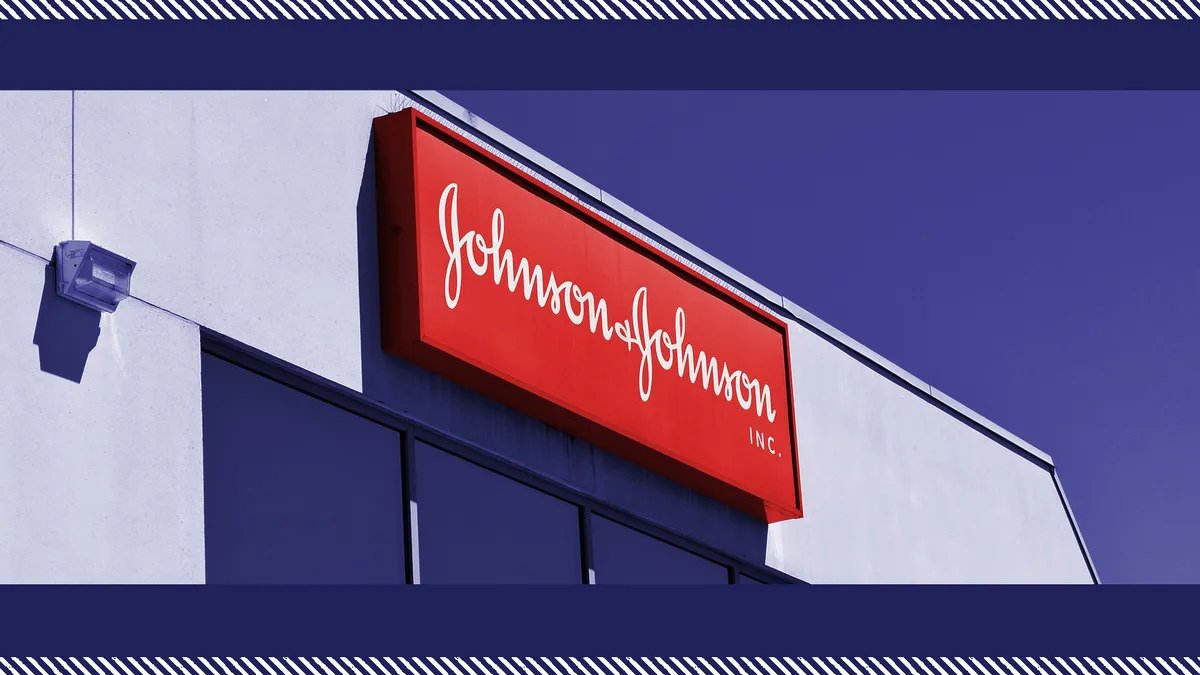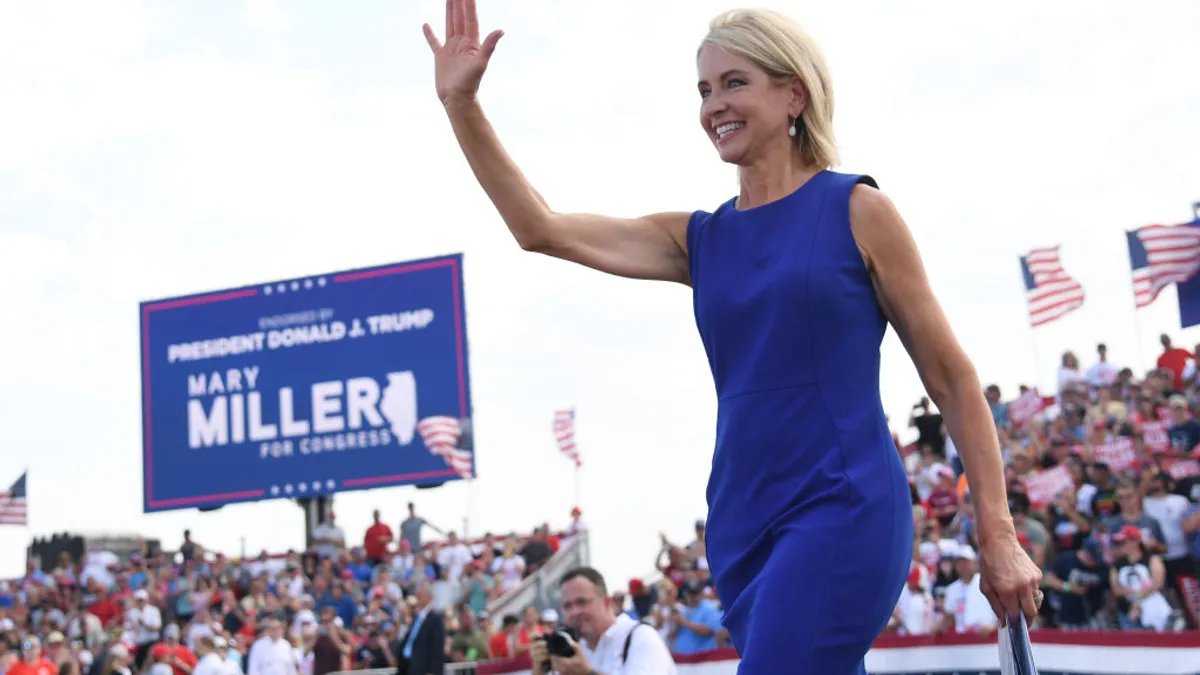As one of the largest employers in the world, with over 132,000 employees, and a healthcare giant with an ecosystem that includes manufacturers, hospital workers and retail consumers, Johnson & Johnson's response to the events of 2020 has required unique agility.
Before the coronavirus pandemic, Johnson & Johnson said it offered its U.S. employees 16 hours of volunteer leave annually, eight weeks parental leave for all new parents and sick leave in addition to PTO. However, the pandemic forced the organization to revise leave and other benefits along with just about every workplace procedure while also making sure it was positioned to keep making essential medical equipment and get to work on a vaccine.
"[In early-March], we immediately sprang into action on our work from home policies," Peter Fasolo, Johnson & Johnson's chief human resources officer, told HR Dive, describing the first 48 to 72 hours after the outbreak became serious in North America. "Within weeks, we had roughly two-thirds of our employees working from home and a third who were on the front line."
The company also enhanced its messaging and efforts around social responsibility in response to the rising movement against racial inequality in America. CEO Alex Gorsky told CNBC "white men need to do more listening." Gorsky's comments came one day after the company pledged $10 million to fight racism and injustice.
"We must take action and leverage the breadth and depth of our company to influence and drive sustainable systemic reform," Johnson & Johnson Chief Diversity & Inclusion Officer Wanda Bryant Hope told HR Dive via email. "One important area of focus: the urgent need to address the inequities in medical care that have long plagued underserved and underrepresented communities — gaps that have recently been both highlighted and exacerbated by the COVID-19 pandemic."
This is how Johnson & Johnson responded to the concurrent challenges of an ongoing pandemic and the movement to hold employers accountable for the state of racial justice in the U.S.
Outbreak in North America
Johnson & Johnson employs more than 11,000 people in China, according to Fasolo, making the country an "extraordinarily important part of the [company's] geography and markets," he said. "We were acutely aware of what was happening in China and mobilizing, at a global level, all the support and resources required."
Having coronavirus on the radar since January gave Johnson & Johnson advance notice of the need to take the outbreak seriously and of different measures it would ultimately need to implement if it became a problem in North America.
"We were getting a lot of insights and a lot of leadership, quite frankly, from our management in China," Fasolo told HR Dive. "We were talking to them regularly about what was happening in the pandemic, how they were responding on the ground with our employees, their families, healthcare providers."
The company also benefited from having scientific expertise within its walls and pre-existing emergency continuity plans, Fasolo said.
"We put together crisis management teams at a global level, at a regional level, a country level, that had line leaders, HR, communications and people from the medical community," Fasolo said. "We stay coordinated every morning on daily calls at a global, regional, country level, and we sat and met as an executive committee daily on what was happening around the globe."
Employee sentiment surveys also played a role in helping Fasolo and his teams navigate the uncertainty of the pandemic's early stages. On a weekly basis, a survey went out to a "stratified random sample" of around 3,000 employees asking how they felt and if newly implemented policies worked.
Almost as important as deploying the surveys is taking action against the results. Fasolo said the input helped company leadership improve benefit policy communications and also provide guidance on work-from-home success, to name some examples.
Johnson & Johnson expanded employee services, including its employee assistance program, which provides access to professional counselors for mental health and well-being that is available to employees and their families. The company also offered complimentary telehealth advice for COVID-19 symptoms, "in an effort to encourage our employees to consider virtual medicine as a first line of defense," a company spokesperson told HR Dive.
Company leadership maintained distinct focus areas for supporting employees working from home: digital mindfulness, resilience, physical and mental health tools. This included workshops and training on these topics as well as tips on everyday activities such as cooking, setting up an ergonomic workspace and boosting the immune system. It also meant improving flexibility in scheduling, with compressed and variable schedules, and even job-sharing and part-time arrangements for employees who needed to work less.
For those who needed to work on-site, the company instituted a variety of workplace enhancements for workers' safety, including social distancing, sanitization and temperature checks. Eligible essential workers also received a $1,000 one-time bonus from the company.
In addition to providing 10 days off for family care leave, company representatives said it expanded family caregiver leave to eight weeks and also allowed qualified medical professionals up to 14 weeks paid "medical personnel" leave. Chief Medical Officer Ed Kuffner used this leave to "work in a COVID-19 unit at Coney Island Hospital during the height of the pandemic" in New York City, according to a statement emailed to HR Dive.
Making a difference
While the pandemic is widely noted as a public health problem, it has also exposed racial gaps in America. The make up of the workforce in essential industries, including manufacturing and healthcare, and access to remote work showed clear racial divides. With respect to the public health side of the problem, Black, Latino and Hispanic people in America are disproportionately represented among coronavirus cases and deaths.
These facts were simmering below the surface before the killings of George Floyd, Breonna Taylor and Ahmaud Arbery led to nationwide protests. This movement led many employers to reconsider how their products, employment practices and external partnerships contributed to inequality and oppression. At that moment, Gorsky's comments to CNBC stood out as an example of a strongly worded statement from corporate America.
"I am proud to work for a CEO who thoughtfully and courageously condemns racism in any form as unacceptable and understood that, in this pivotal moment in our history, it was important to affirm that black lives matter," Hope said. "He has challenged his peers and all colleagues at J&J to step up and do more as peaceful and determined agents of change."
Since taking over in the chief diversity and inclusion role in 2015, Hope has aligned the executive committee around a corporate diversity mission, vision and expectations for how to achieve the goals outlined. This included changes to the credo, unconscious bias training, recognition programs for standout D&I efforts, and expanding support for employee resource groups.
This year, Hope said she plans to increase training around unconscious bias and also "conscious inclusion," in the interest of improving internal diversity "to reflect the markets we serve."
Recognizing the company's external responsibility, Hope also plans for the company to offer educational programming, such as this June Q&A with Johnson & Johnson EVP Michael Sneed on racial gaps in healthcare and the workplace. Hope also said the company plans to "leverage our long-standing partnerships and reach to advance action that addresses systemic inequities and drives sustainable reforms."
"J&J has made significant progress in advancing a more inclusive world, building a diverse workforce for the future and delivering innovative health solutions for all — including underserved and underrepresented communities which often experience healthcare disparities," Hope said. "Recent events compel us to do more."





















